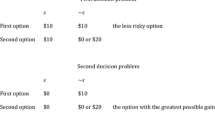Abstract
We provide a new behavioral foundation for subjective expected utility (SEU) within the Anscombe–Aumann framework. In contrast to the original axiomatization of SEU, our behavioral foundation establishes that to be consistent with SEU maximization, we need not explicitly assume that preferences satisfy the independence axiom over the domain of all acts. Rather, the substantive implications of independence for an SEU representation may equivalently be derived from less demanding conditions over certain smaller classes of acts. These acts, which we refer to as uncertainty-free comparable acts, have the property that they are relatively simple for a decision maker to compare because she can rank acts within any such class based on her risk preferences alone, without having to consider the underlying uncertainty. Acts of this kind comprise constant acts and acts that are almost identical in the sense that they differ from one another in at most one state.
Similar content being viewed by others
Notes
For instance, the leading models accommodating ambiguity-sensitive behavior that have been proposed in the literature in the last two decades or so have mostly worked within this framework.
An act is constant if it gives the same objective lottery in each state.
This should also be evident from the fact that this axiom is weaker than the certainty independence axiom underlying the multiple prior model of Gilboa and Schmeidler (1989) that, of course, accommodates the Ellsberg preferences.
For instance, for any two acts from this set (other than \(b_E\)) and for any state outside \(E\), the ratio of the payment under these acts is constant.
In the earlier version of the paper, instead of UF C-independence, we had used an axiom stronger than it to establish this result. This axiom, which we referred to as uncertainty-free comparable independence, went as follows:
-
If each pair of acts \((f,f')\) and \((g,g')\) are uncertainty-free comparable, and furthermore \(f'\sim g'\), then \(f\succsim g\Leftrightarrow \alpha f+(1-\alpha )f'\succsim \alpha g+(1-\alpha )g'\).
One of our referees provided us with an alternative proof which showed that UF C-Independence, along with the other axioms, suffices for an SEU representation. The proof that we provide in the appendix for our representation result is along the lines suggested by this referee. We gratefully acknowledge the suggestion made by this referee toward strengthening our result and, accordingly, the argument of the paper.
-
For this case where the set of states is not finite, our earlier terminology of almost identical acts looses its intuitive appeal. So, it is not very instructive to introduce this terminology here. Rather, it is more useful to look at acts like \((p,f_{A^C})\) and \((q,f_{A^C})\) purely from the perspective of permitting uncertainty-free comparisons.
References
Anscombe, F. J., & Aumann, R. J. (1963). A definition of subjective probability. Annals of Mathematical Statistics, 34(1), 199–205.
Fishburn, P. C. (1970). Utility theory for decision making. New York: John Wiley and Sons.
Ghirardato, P., Maccheroni, F., & Marinacci, M. (2004). Differentiating ambiguity and ambiguity attitude. Journal of Economic Theory, 118(2), 133–173.
Gilboa, I., & Schmeidler, D. (1989). Maxmin expected utility with non-unique prior. Journal of Mathematical Economics, 18, 141–153.
Klibanoff, P., Marinacci, M., & Mukerji, S. (2005). A smooth model of decision making under ambiguity. Econometrica, 73, 1849–1892.
Lehrer, E., & Teper, R. (2015). Subjective independence and concave expected utility. Journal of Economic Theory, 158, 33–53.
L’Haridon, O., & Placido, L. (2010). Betting on Machina’s reflection example: An experiment on ambiguity. Theory and Decision, 69(3), 375–393.
Maccheroni, F., Marinacci, M., & Rustichini, A. (2006). Ambiguity aversion, robustness and the variational representation of preferences. Econometrica, 74, 1447–1498.
Machina, M. J. (2009). Risk, ambiguity, and the rank-dependence axioms. The American Economic Review, 99(1), 385–392.
Savage, L. J. (1954). The foundations of statistics. New York: Dover Publications.
Schmeidler, D. (1989). Subjective probability and expected utility without additivity. Econometrica, 57, 571–587.
Acknowledgments
We thank Itzhak Gilboa for encouraging us to think about the subject matter of this paper. We also greatly appreciate comments from Roee Teper and Marciano Siniscalchi. The present version of the paper has greatly benefitted from some incisive comments made by two anonymous referees and the coordinating editor. Of course, any shortcomings in the paper are our responsibility.
Author information
Authors and Affiliations
Corresponding author
Rights and permissions
About this article
Cite this article
Borah, A., Kops, C. The Anscombe–Aumann representation and the independence axiom: a reconsideration. Theory Decis 80, 211–226 (2016). https://doi.org/10.1007/s11238-015-9498-8
Published:
Issue Date:
DOI: https://doi.org/10.1007/s11238-015-9498-8




